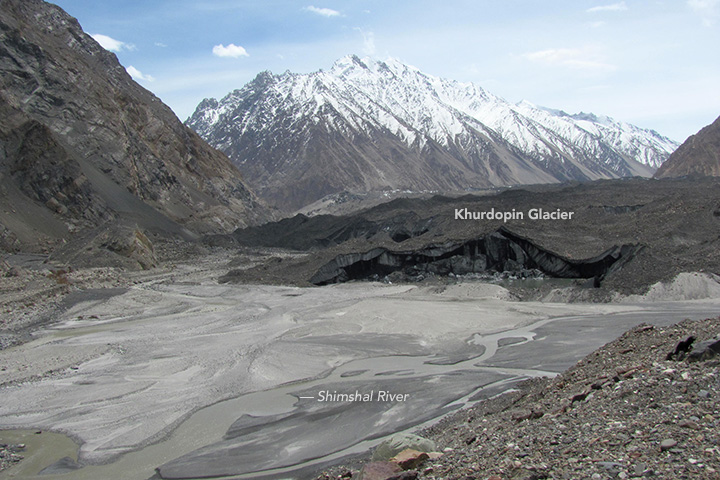Archivo: Khurdopin glacier & Shimshal River
Descripción: Several of the glaciers that flow into this valley surge, meaning they cycle through periods when they flow forward several times faster than usual. Since the valley is narrow and has a river running through it, surging glaciers regularly dam the river and create flood hazards. The floods occur when water pooling up behind the tongue of the advancing glacier suddenly breaks through the natural ice dam and cascades down the gorge. Khurdopin has surged most recently. After years of little movement, the glacier began a rapid advance in October 2016, accelerating to a rate of roughly 20 meters (65 feet) per day by the spring of 2017—one of the fastest rates observed for a glacier in this region. As ice and sediment pushed into the river, a sizable lake pooled up in March 2017. Jakob Steiner of Utrecht University and the Mountain Hydrology Group has been monitoring the growth of the lake using imagery collected by Landsat 8 and Planet Labs, a commercial satellite company. By July 2017, the river had carved an outlet through the glacial debris before the lake could grow extremely large, but Steiner’s group continued to keep a watchful eye on this area because of how much debris the glacier pushed into the river. The surge increased the thickness of the end of the glacier by as much as 80 meters (260 feet), according to Steiner. The photograph above, taken by Waheed Anwar of Focus Pakistan, shows the tip of the sediment-coated glacier pushing into the river on May 15, 2017. The camera is pointed upstream toward Khurdopin glacier.
Título: Khurdopin glacier & Shimshal River
Créditos: https://earthobservatory.nasa.gov/IOTD/view.php?id=90672&src=eoa-iotd
Autor(a): Waheed Anwar and NASA Earth Observatory
Permiso: Public domainPublic domainfalsefalse Este archivo es de dominio público porque fue creado por la NASA. Las políticas sobre copyright de la NASA estipulan que «el material de la NASA no está protegido con copyright a menos que se indique lo contrario». (Políticas sobre copyright de la NASA o Políticas sobre la utilización de imágenes del Jet Propulsion Laboratory). Advertencias: El uso del logotipo de la NASA (incluidos el logotipo actual y los anteriores) está restringido. El sitio web de la NASA almacena una gran cantidad de imágenes del Programa Espacial de la URSS, de la Agencia Espacial Federal Rusa y otras agencias espaciales no estadounidenses. Estas imágenes no son de dominio público. Material del Telescopio espacial Hubble puede tener copyright si no proviene explícitamente del Space Telescope Science Institute. [1] Todo el material creado por la sonda espacial SOHO está protegido por copyright y requiere permiso para ser utilizado con fines comerciales o no educativos. [2] Las imágenes que figuran en el sitio web Astronomy Picture of the Day (APOD) pueden tener copyright. [3]
Términos de Uso: Dominio Público
Licencia: Dominio Público
¿Se exige la atribución?: No
Usos del archivo
La siguiente página enlaza a este archivo:


